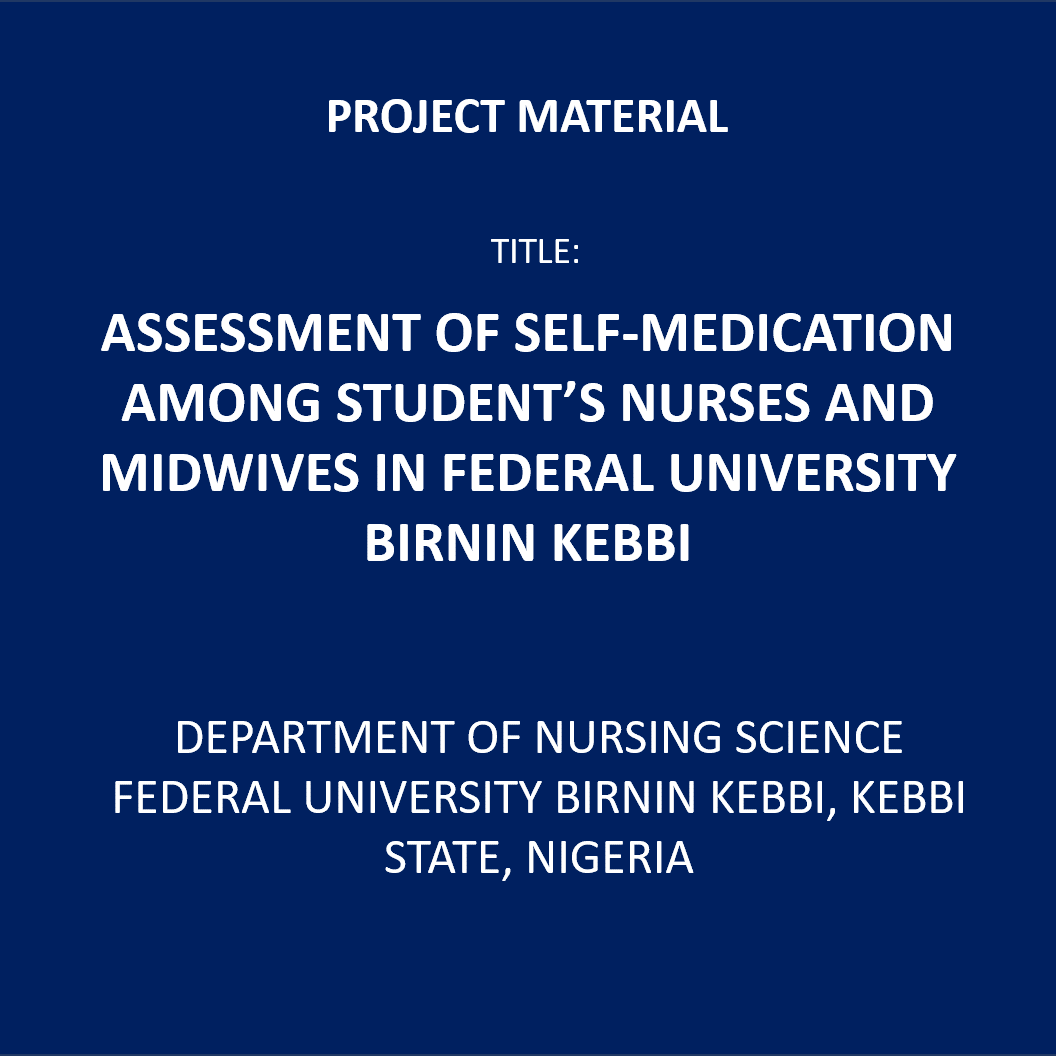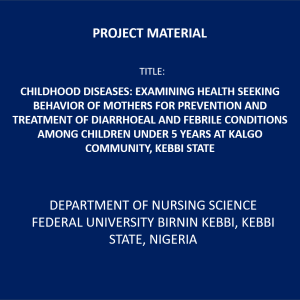No products in the cart.
Assessment of Self-Medication Among Student’s Nurses and Midwives
₦10,150.00
This study was intended to covers the assessment of self-medication and its effect among student nurses and midwives in Federal university Birnin Kebbi, putting into consideration demographic factors as possible influencing factors regarding the subject matter
BACKGROUND OF THE STUDY
Self-medication is a commonly seen phenomenon (Agbor & Azodo, 2013). The term self-medication (SM) refers to the use of drugs to treat self-diagnosed disorders or symptoms, or the intermittent or continued use of a prescribed drug for chronic or recurrent disease or symptoms (Afridi, Rasool, & Rabia Tabassum, 2015). According to World Health Organization (WHO) self-medication is the selection and use of medicines by person to treat self-recognized illness or symptoms. It is one of the health problems in many countries, including Nigeria (Bassi et al., 2021).
Globally, self-medication has been reported as being on the rise. People around the world tend to treat the disease themselves. Almost 50% either wait for the problem to run its course or use a home remedy. About 25% visit doctor or use prescription medicine previously obtained for the same condition. The remaining 25% turn to the over the counter (OTC) medicines (Hgiano et al., 2016). Behzadifar et al., 2020 viewed self-medication as one of the main social issues on economic and health systems with variety in prevalence based on contextual determinants such as education level, knowledge, income, and gender.
Fereidouni and Najafi, 2019 also reported that the prevalence of self-medication has increased dramatically worldwide. Evidence suggests that about 80% of all medications in developing countries can be bought without prescriptions. Self-medication, due to its lower cost, is a substitute for people who cannot afford proper medical care (Akram et al., 2018).
Responsible self-medication practices which require a certain level of knowledge and health orientation can have a positive impact on individuals and health care systems. It allows patients to take responsibility and build confidence to manage their own health, thereby promoting self empowerment (Joshua & Christopher, 2018). Furthermore, it can reduce the work load on the medical services, decrease the time spent in waiting to see the physician, even save lives in acute conditions, and thereby may contribute to decreasing health care costs especially in economically deprived countries with limited health resources (Mihretie, 2014). The World Health Organization has also pointed out that responsible self-medication can help to prevent and treat ailments that do not require medical consultation, and provides a cheaper alternative for treating common illnesses (WHO, 2019).
Regard less of the unquestionable benefits obtained from self-medication with non-prescription drugs, there are undesired outcomes that occur, due to improper usage. These have been indicated in studies where self-medication may have increased risks of misdiagnosis, overdose of drugs, incorrect duration of use, and adverse drug reactions related to the improper use of OTC drugs (Ruiz, 2020).
Inappropriate self-medication results in irrational use of drugs, wastage of resources, increased risk of unwanted effects, and prolonged suffering (Buck, 2017). Irrational usage of antibiotics leads to the emergence of resistance pathogens worldwide (Angamo & Wabe, 2013). Furthermore, risks associated with self-medication also include potential delay in treating serious medical conditions, masking of symptoms of serious conditions through the use of non-prescription products, and increased polypharmacy and interaction with other commonly used medications (Pagane, 2017). Even though self-medication is difficult to eliminate, interventions can be made to discourage the abnormal practice. Improving self-medication practice requires focused continuous education of both the public and health professionals to avoid irrational use of drugs (Ezeoke, 2019).
Self-medication patterns vary among different populations, and are influenced by many factors, such as age, sex, income, expenditure, self-care orientation, level of education, medical knowledge, satisfaction, and perception of illnesses. The type and extent of self-medication and the reasons for its practices may also vary from country to country (Joshua & Christopher, 2018).
Evidence suggests that the prevalence of self-medication is relatively high among medical science students in different countries. In this regard, the prevalence of arbitrary drug use has been reported to be 78.6% in India, 76% in Brazil, 78.5% in Jordan, 97.5% in Kuwait, 70.1% in Iran (Janatolmakan et al., 2022). In Nigeria, it ranges from 60-90% (Bassi et al., 2021).
Today, the arbitrary use of drugs is increasing among the young people, especially students, and the probability of self-medication is greater among nursing students because of their easy access to information sources and their relative familiarity with different drugs (Elden et al., 2020). Previous studies have shown that among undergraduate students of Nigerian universities, the prevalence of self-medication was 67% and this has posed major problems to their health. These include adverse drug reactions, drug resistance, waste of resources, and serious health risks such as death (Afolabi, 2019).
There are numerous reasons for self-medication. In this regard, the results of a study in some states in Nigerian showed that previous experience, access to pharmacies, family pressure, and availability of medications at home were among the reasons for self-medication in medical science students (Kassie et al., 2018). The mildness of the disease and previous knowledge about medications are among other reasons for self-medication (Abdi et al., 2018).
Studies show that college students have very low tendency to consult health professionals to seek health-related information, to get treatment, or to obtain other healthcare services (Brena & Gowda, 2001). In the recent years of increased social media influence, students rely more on the Internet for information regarding their health rather than consulting healthcare professionals (Hanauer et al., 2014). This increases the likelihood of practicing self-medication among college students to treat self-diagnosed illnesses (Ryan & Wilson, 2018).
Previous studies by James et al., 2006 have shown that medical knowledge is one of the factors that could have an impact on self-medication practice among college students. With the assumption difference in the level of preexisting medical knowledge, several studies have compared self-medication between medical and nonmedical students (Sawalha, 2008 & Esan, 2018.). However, it is difficult to establish a clear relationship between the role of medical education and self-medication practice among students because of divergent results of the studies (Zelalem et al., 2020).
Few studies have been issued previously on self-medication practices of Nigerian college students (Zelalem et al., 2020). However, due to the fast-changing sociocultural environment in Nigerian universities, it is important to analyse the contemporary status of self-medication practice among students. Moreover, Assessment of self-medication among student nurses and midwives in Federal university Birnin Kebbi is important to identify the reason for self-medication practice as well as to provide baseline information for researchers and public health officials who work on the subject.

